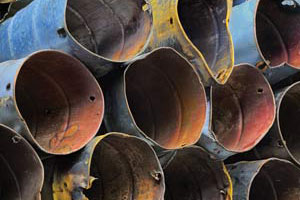Just how long does it take for conventional plastics to completely break down? 500 years? 1,000? It’s a mystery. “No one has really measured how long it takes,” says Ramani Narayan, a professor of chemical and biochemical engineering at Michigan State University. What is known is that conventional petroleum-based plastics never really go away, even when they break down into pieces too small to be seen with the naked eye. Some new plastics are designed to degrade (not to be confused with biodegrade—more on that in a sec) in a matter of weeks when exposed to the elements, but that doesn’t mean they’re truly gone.
But broken down plastics are better than litter, right? Wrong. In fact, plastics often create more environmental harm when broken down than when intact. This is most evident in the oceans, home to billions of pieces of disintegrating plastic and preproduction pellets called nurdles, which can work their way back up the food chain to humans.
What about biodegradable plastics? They’re pretty neat: Microorganisms can convert biodegradable plastics into water, carbon dioxide, and biomass—with no nasty chemical leftovers. However, there is a lot of confusion surrounding these ecofriendlier plastics—some of it intentional. “This word ‘biodegradable’ has become very attractive to people trying to make quick bucks on it,” explains Narayan, who helped develop biodegradable corn-based plastic. Some companies, he says, are making conventional plastic that degrades quickly and then throwing around claims about biodegradability that are unproven or just too good to be true.
Can biodegradable plastics break down in landfills? This claim, which now shows up on everything from water bottles to trash bags to Discover’s “biodegradable PVC” credit cards, is “disingenuous at best,” says Narayan. Usually, nothing biodegrades in a landfill. But if biodegradable plastics do break down in this oxygen-free environment, they’ll emit methane, a greenhouse gas 23 times more potent than CO2.
How do I avoid fake biodegradable plastics? Currently, truly biodegradable plastics are mostly used for eating utensils, food containers, and compostable bags. To make sure you’re getting the real deal, look for products with the Biodegradable Products Institute logo, which means they’ve been certified to comply with strict scientific standards.
So what’s the best way to get rid of biodegradable plastic? “The public thinks that biodegradability means ‘If I throw it away, it will completely go away,'” says Narayan. “They don’t even know what ‘going away’ means.” Real biodegradable plastic should be sent to a commercial composting facility, where it will spend its final days being eaten by microbes. But here’s the catch: In 2007, only 42 communities nationwide offered compost collection. (Seventeen were in California.) And though some biodegradable plastics can be recycled, no curbside recycling program will take them. So before you buy biodegradable plastics, make sure you can help them “go away” the right way.














